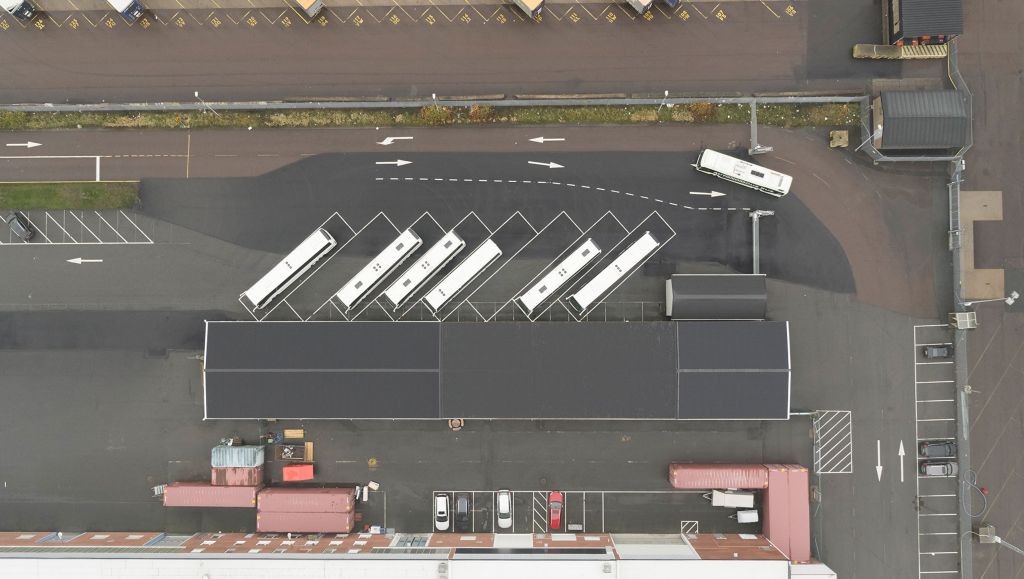Bus depots - A likely first step towards automation


As confined, controlled spaces with predictable traffic flows, bus depots are currently amongst the most feasible areas for the introduction of self-driving vehicles. Unlike public roads, there is no interaction with pedestrians and other road users, and many of the current legal barriers to automation are not applicable. It is for this reason increasing numbers of bus operators and public transport operators are investigating the potential for using automated technology in their depots.
A recent study undertaken by a team of researchers at the Karlsruhe Institute of Technology in Germany, looked into the potential benefits of self-driving vehicles in a bus depot in Stuttgart-Gaisburg. Each day, 150 local public transport buses pass through the depot, stopping at multiple stations for refuelling, cleaning (exterior and interior), maintenance and repairs, inspection and parking. The study found that the movement between most of these stations could be performed by self-driving vehicles using existing technology. The only function that could not be delegated was the interior cleaning and damage inspection, which are too complicated to be performed by robots. It is estimated that this would save the depot more than €100,000 per year in personnel costs. It would also have the added benefit of increased throughput, fewer minor accidents and collisions, and would free up personnel for tasks such as vehicle service and other assignments that increase quality.
“What was really surprising to me was how little effort is required to achieve a cost reduction,” says Professor Eric Sax, co-author of the study. “Of course, software needs to be developed to calculate the trajectories, but this is based on common sensors in the vehicle. They capture ordinary signs such as traffic lights and road marks, and of course recognise obstacles in the vehicle’s planned route. Without much additional equipment on the vehicle and no additional infrastructure, our study showed that there is a strong business case for automation and a real opportunity.”
The study also argues that the concept applied to the Stuttgart-Gaisburg depot is scalable to other depots and that its findings could be used in the planning of future depots. “The Stuttgart-Gaisburg depot was a very compact area, with short distances, and only 150 buses. There are many other depots that are even better suited to automation, where the savings could be even greater. It depends on the number of buses and how many minutes drivers spend in the vehicle, but clearly the opportunities are out there.”
After their successful study into the Stuttgart-Gaisburg depot, Professor Eric Sax and his colleagues are now working in close cooperation with selected public transport companies in Germany, to help realise their concept in real operation. Professor Sax believes that this could be an important starting point for autonomous driving in general.
“We have a long way to go before we can operate a self-driving vehicle in regular city traffic, because there are still so many unanswered questions,” he says. “However, starting in a small niche, like a bus depot, is a wonderful first step. It helps us learn and gain experience in situations that we can control, which will help us to take the next steps.”
Volvo Buses is also seeing increased interest from the industry in automated solutions, and anticipates growing demand from customers in the coming years.
“When we look at the areas that are most important to our customers – uptime, energy efficiency, safety, driver performance and passenger satisfaction – automation is set to have a big impact and it will be a game changer when it reaches public roads,” says Marie Carlsson, Director Business Solutions, Volvo Buses. “It might not happen for another 10 years, but we need to start thinking about it now, and we believe bus depots will be a good first step.”
However, Marie Carlsson believes automation is likely to be introduced in stages, through increasingly automated solutions, with fully automated vehicles being the likely end point. “We already today have systems for supporting the driver that use automated technology such as active safety systems,” she explains. “Ultimately the reason for exploring automation is to make public buses safer, smarter, cleaner, more comfortable and more efficient, and we are already on that path.”
Autonomous depo driving is a part of research project that is partly funded by FFI - Fordonsstrategisk Forskning och Innovation (Strategic vehicle research and innovation).